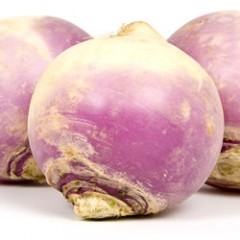Turnips
 Roughly 172 acres of turnips are produced on 50 farms in New York (2012 Census of Agriculture). Turnips are in the Brassicaceae or cabbage family, which includes radishes. Seeds are planted in the spring or early summer for harvest from May through November. Turnips store well over the winter and are a good crop for winter farmers markets.
Roughly 172 acres of turnips are produced on 50 farms in New York (2012 Census of Agriculture). Turnips are in the Brassicaceae or cabbage family, which includes radishes. Seeds are planted in the spring or early summer for harvest from May through November. Turnips store well over the winter and are a good crop for winter farmers markets. Relevant Events
2025 Potato Advisory Meeting
December 16, 2025
Canandaigua, NY
2026 Finger Lakes Produce Auction Winter Growers Meeting
January 8, 2026
Penn Yan, NY
Cabbage Maggot Control in Brassicas, 2024
Christy Hoepting, Extension Vegetable Specialist
Cornell Vegetable Program

Since the brassica industry's go-to for cheap, easy and effective control of cabbage maggot, Lorsban along with its generic products (active ingredient chlorpyrifos) was banned in 2021, Brian Nault (Cornell Entomology) and Cornell Vegetable Program Specialist Christy Hoepting have been conducting cabbage maggot trials annually from 2021 to 2023 in search of an effective and affordable alternative. Read our key findings and the 2024 Cornell "Cheat Sheet" for Insecticide Options for Cabbage Maggot in Brassicas in New York.
New Crop Rotation Recommendations for Swede Midge
Christy Hoepting, Extension Vegetable Specialist
Cornell Vegetable Program

New Cornell research has demonstrated that brassica crop rotations of 500 ft (down from 3000 ft) and 3 months (down from 3 years) could effectively "crash" a swede midge population when fields are secluded from each other, making crop rotation a much more feasible strategy for small farms. A new fact sheet details the new crop rotation recommendations and provides information on the pest's life cycle, biology, and crop preferences in addition to real-world examples of crop rotation. The crop rotation strategies were developed to serve the needs of small organic farmers, but have utility for conventional farmers as well.
Video: New York State Produce Auctions

Currently, there are 8 produce auctions in New York State. These auctions are aggregation points that allow local farmers to sell their produce in wholesale lots to buyers from across the region. To document the economic impact of produce auctions on agriculture, local businesses, family farms, and produce buyers, the Cornell Vegetable Program worked with Harvest New York to survey top sellers and buyers.
A new Cornell Vegetable Program video shares general information about produce auctions, how buyers and sellers use the auctions to expand their businesses, and how local communities benefit from them.
Video: Swede Midge

Swede midge is an invasive insect pest that is threatening the viability of broccoli, cauliflower, cabbage, Brussels sprouts, kale, kohlrabi and turnip production within the Cornell Vegetable Program region and throughout the Northeastern US. This short video will provide you with some general information about this pest and how to scout for it in your Brassicas.
Video: Flea Beetles

Flea beetles are a common vegetable pest affecting peppers, cucurbits, sweet potato, potato, peas, beans, beets, tomato, corn, turnip, pumpkin, melon, eggplant, and others. This short video gives you some general information about this pest.
Cold Storage Chart and Reference Guide to Commercial Vegetable Storage
Robert Hadad, Extension Vegetable Specialist
Cornell Vegetable Program

Commercial vegetable growers will find a Cold Storage Chart by crop type with temperature and relative humidity recommendations. The maximum number of weeks that the crop can be held under ideal conditions is provided as well.
Adapted from the USDA Bulletin #66, The Commercial Storage of Fruits, Vegetables, and Florist and Nursery Stock, growers will find information on quality, grading, sizes, and packaging, chilling and storage, and post-harvest pathology of vegetables.
Crop Cooling and Storage
Robert Hadad, Extension Vegetable Specialist
Cornell Vegetable Program

On-Farm Cold Storage of Fall-Harvested Fruit and Vegetable Crops is an in-depth look at the planning and designing cooling for late season and winter storage but it also is useful for general cooling as well. This was written by Scott Sanford, Distinguished Outreach Specialist, UW-Extension, and John Hendrickson, Outreach Program Manager, Center for Integrated Agricultural Systems, University of Wisconsin-Madison.
O-zone Injury on Vegetables
Crystal Stewart-Courtens, Extension Vegetable Specialist
Eastern New York Commercial Horticulture

Hot, humid weather with stagnant air masses may lead to ozone damage on crops. Ozone warnings were recently issued for much of New York. These warnings are intended for people with respiratory problems and let them know they should limit their outdoor activity and try to stay as much as possible in air-conditioned locations. These warning are also a good indicator that ozone damage may occur in plants.

Upcoming Events
2025 Potato Advisory Meeting
December 16, 2025
Canandaigua, NY
Come hear the latest on insect pest control and fertility management in potatoes from Cornell University experts. Potato variety trial updates will be shared too. After lunch will be the Empire State Potato Grower's Meeting. 1.5 DEC credits in 10, 1a, and 23.
2026 Finger Lakes Produce Auction Winter Growers Meeting
January 8, 2026
Penn Yan, NY
At this vegetable grower-focused meeting, ag industry experts will discuss food safety, disease management in strawberries, the benefits of using cover crops, plus more. Two grower panel discussions will focus on pest management techniques and irrigation. DEC recertification credits offered in categories 10, 1a, 21, 22, 23, and 24.


































